 We’re enjoying our stay here on the Texas Coast; there’s a bit of everything to see and do, from the big city to quiet rural areas. We frequently make the 25 mile drive down the road to Corpus Christi, a typical large town with the usual strip malls and crowded roads. What sets Corpus Christi apart is the waterfront – miles of parks and marinas provide great places to take the kids, have a picnic, or just watch the abundant shorebirds and occasional dolphin as they hunt for fish.
We’re enjoying our stay here on the Texas Coast; there’s a bit of everything to see and do, from the big city to quiet rural areas. We frequently make the 25 mile drive down the road to Corpus Christi, a typical large town with the usual strip malls and crowded roads. What sets Corpus Christi apart is the waterfront – miles of parks and marinas provide great places to take the kids, have a picnic, or just watch the abundant shorebirds and occasional dolphin as they hunt for fish.
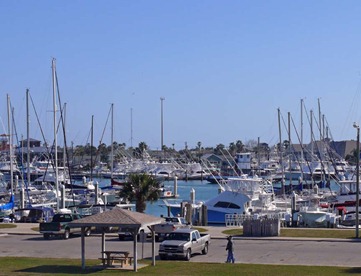 Another of our favorite places to visit is Port Aransas, a short (and free) ferry ride across the bay. Port Aransas has the usual tourist spots, and a large marina next to the ferry landing. From an observation
Another of our favorite places to visit is Port Aransas, a short (and free) ferry ride across the bay. Port Aransas has the usual tourist spots, and a large marina next to the ferry landing. From an observation 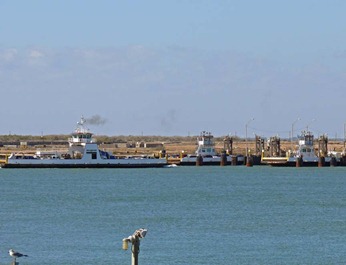 tower, we watched as the ferries worked their way back and forth – we’ve never waited more than 10 minutes to drive on. There are at least eight ferry boats, with crews both on board and on the loading areas, all to cross a short distance – we wonder why they don’t just build a bridge?
tower, we watched as the ferries worked their way back and forth – we’ve never waited more than 10 minutes to drive on. There are at least eight ferry boats, with crews both on board and on the loading areas, all to cross a short distance – we wonder why they don’t just build a bridge?
A short distance from the ferry landing is a birding center – a good sized lagoon with a wooden walkway and observation tower. 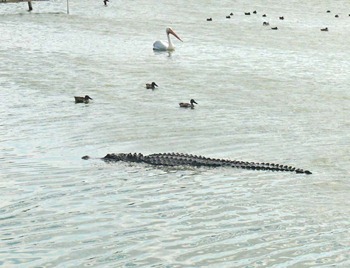 This time of year the water is covered with ducks; mostly Teal, Pintail, and Shovelers, but on our last visit we were surprised to see a large, and I mean LARGE, alligator prowling the pond. He was around 10 feel long, with a massive head, and we watched
This time of year the water is covered with ducks; mostly Teal, Pintail, and Shovelers, but on our last visit we were surprised to see a large, and I mean LARGE, alligator prowling the pond. He was around 10 feel long, with a massive head, and we watched 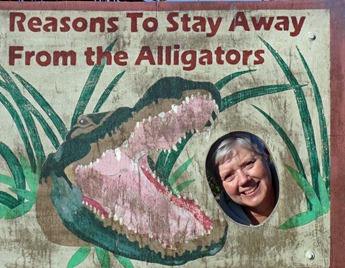 as he worked his way through the shallow water and mud. The waterfowl didn’t seem too alarmed, but they didn’t get too close, either. Since the reeds were crowded with sleeping ducks, he probably didn’t have to work too hard to find a meal. I guess there’s a reason for the cute sign warning of alligators after all!
as he worked his way through the shallow water and mud. The waterfowl didn’t seem too alarmed, but they didn’t get too close, either. Since the reeds were crowded with sleeping ducks, he probably didn’t have to work too hard to find a meal. I guess there’s a reason for the cute sign warning of alligators after all!
On one of our road trips we came across the interesting story of the town of Indianola. A few years ago we came across the tiny town of Pana Maria, and found that it is the oldest Polish settlement in the United States, settled by immigrants that landed in Galveston. This surprised us, since like most people, we assumed that European immigrants all entered the U.S. at Ellis Island. Indianola (known as Indian Point until 1848) provided us another surprise – in it’s day, it was the second largest port in Texas, and one of the first ports in the U.S. that Germans immigrated through. The story of Germans and Indianola is not well known, but should be - in short, over four thousand immigrants landed in December, 1844 expecting an easy trip to their new land in San Antonio and New Braunfels. Instead, they found no transportation, buildings, potable water, or supplies, but plenty of mosquitoes, rain, and cold. In the next two years, of the little over 5000 total immigrants that landed, over 2000 lost their lives to cholera, typhoid, and meningitis. Even the Pilgrims at Plymouth Rock fared better. In 1849, the town’s name was changed to Indianola and by now, most of the immigrants had moved on, although enough stayed to bolster the town’s population to over 1000 by 1860. Indianola soon became the primary destination for supplies destined for the West, including the camels for the ill-fated US Camel Corps. Civil war battles were fought here, a hospital and a railroad depot were built, and the population swelled to 5000. But in 1875 a hurricane struck the town, pushing water 20 miles inland, destroyed 75 percent of the buildings , and killed 176. Much of the town was rebuilt, but in 1886 an even stronger hurricane struck, devastating the town and forever ruining the harbor. The town was abandoned.
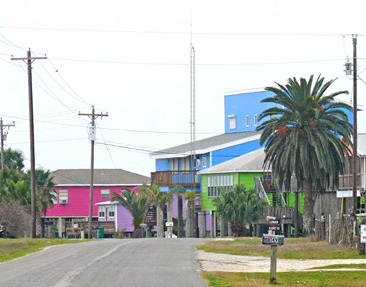 Today, there are just a few beach houses where the town once stood. We found the site of the original courthouse, and visited the cemetery where entire families are interred from the hurricanes.
Today, there are just a few beach houses where the town once stood. We found the site of the original courthouse, and visited the cemetery where entire families are interred from the hurricanes. 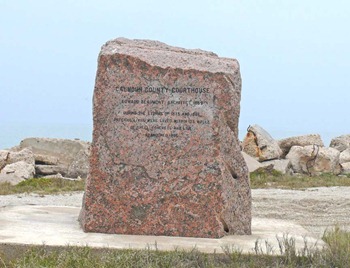 It’s hard to believe looking around that this was once such a vibrant town and important seaport, and it’s too bad that there isn’t more information available about the lives of the people here. Can you imagine a time when a hurricane appeared without warning? What would we do without “Storm Tracker Doppler High-definition Weather Radar”? Whatever that is.
It’s hard to believe looking around that this was once such a vibrant town and important seaport, and it’s too bad that there isn’t more information available about the lives of the people here. Can you imagine a time when a hurricane appeared without warning? What would we do without “Storm Tracker Doppler High-definition Weather Radar”? Whatever that is.
Stay tuned, we’re still exploring the area – come back and visit!
We’ve been enjoying the warm weather here on the coast – most days are in the 70s, and although often overcast, we’ve had little rain. It’s been “top down” weather, and we’ve been having a great time exploring the coast. This is the home for many migratory waterfowl and shorebirds, and the marshes, ponds, and fields have been full of winter residents. One of the 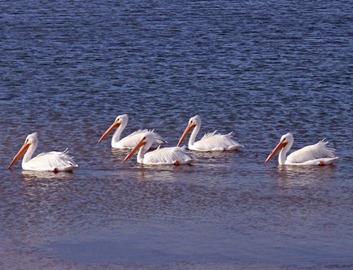 most prolific is the White Pelican – it’s rare to find a body of water without a group of them, strung out in a line as they herd baitfish into shallow water. There’s so interesting to watch – almost clownish, yet still graceful the way they move through the water. We stopped at a fishing pier cleaning station where several fisherman were throwing pieces of fish to a group of White Pelicans with a few Brown ones mixed in. As the fisherman would raise his hand to throw, all of those huge beaks would rise together as if choreographed.
most prolific is the White Pelican – it’s rare to find a body of water without a group of them, strung out in a line as they herd baitfish into shallow water. There’s so interesting to watch – almost clownish, yet still graceful the way they move through the water. We stopped at a fishing pier cleaning station where several fisherman were throwing pieces of fish to a group of White Pelicans with a few Brown ones mixed in. As the fisherman would raise his hand to throw, all of those huge beaks would rise together as if choreographed.
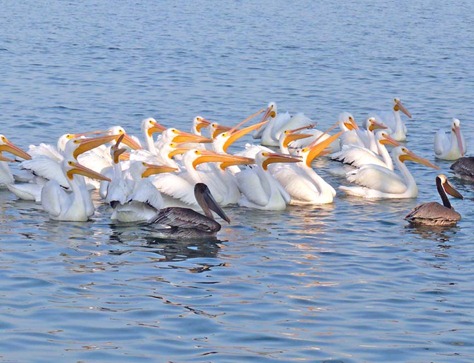
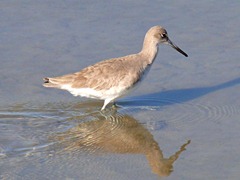 There are dozens of state and city parks on the water that provide great places for birdwatching, and there’s always a group of 5th-wheel hauling pickups in the parking lot of each, with license plates from Minnesota, Wisconsin, and other northern states. This is non-breeding season for birds and waterfowl, so most, like this Willett, are not very colorful, although some, like the Roseate Spoonbill, still manage to show a hint of their beautiful rose hues.
There are dozens of state and city parks on the water that provide great places for birdwatching, and there’s always a group of 5th-wheel hauling pickups in the parking lot of each, with license plates from Minnesota, Wisconsin, and other northern states. This is non-breeding season for birds and waterfowl, so most, like this Willett, are not very colorful, although some, like the Roseate Spoonbill, still manage to show a hint of their beautiful rose hues.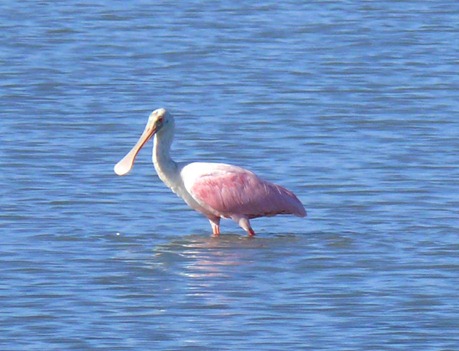
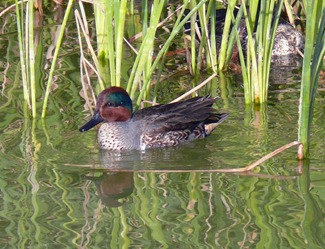 At one large pond, we were amazed by the number of ducks – Northern Shoveler, Green and Blue-winged Teal, Ruddy, and Red-headed ducks were everywhere, mixed in with Cormorants, both Double-crested and their smaller cousin, the Neotropic. The Green-winged Teal were very colorful, but it was a Northern Shoveler, preening himself that caught our attention with his vibrant colors.
At one large pond, we were amazed by the number of ducks – Northern Shoveler, Green and Blue-winged Teal, Ruddy, and Red-headed ducks were everywhere, mixed in with Cormorants, both Double-crested and their smaller cousin, the Neotropic. The Green-winged Teal were very colorful, but it was a Northern Shoveler, preening himself that caught our attention with his vibrant colors.
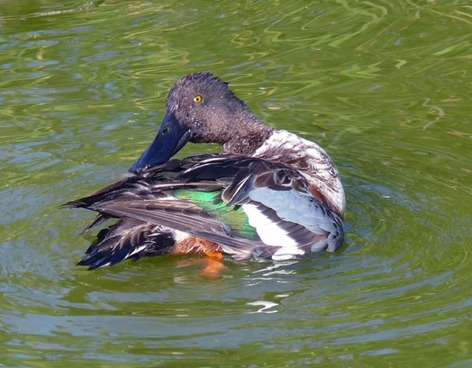 The water isn’t the only place to see waterfowl – drive down almost any rural road and you’ll see hundreds of Snow
The water isn’t the only place to see waterfowl – drive down almost any rural road and you’ll see hundreds of Snow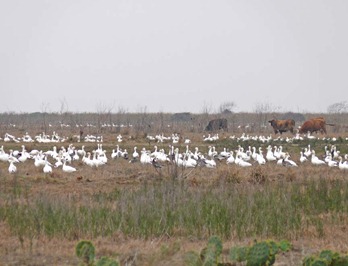 Geese in the fields, grazing alongside cattle. We stopped to watch one large gaggle, and when I got out of the car to take a picture, the field erupted with hundreds of noisy, wing-flapping, quacking geese as they took off. It was an awesome sight, but naturally my camera wasn’t handy to capture it.
We’ve become enthusiastic wildlife watchers and have come a long way from our working days when we identified birds as “Robins and all others”, and ducks as “Mallards and all others”. It’s been a wonderful part of our post-working life, and our thanks to Bob and Deb at Lee Metcalf National Wildlife Refuge (our first volunteer location), for their patience in helping us appreciate the magic of “birding”!
We’re also exploring historical sites, backcountry roads, and of course, restaurants, so check back and see what we’ve found!
Geese in the fields, grazing alongside cattle. We stopped to watch one large gaggle, and when I got out of the car to take a picture, the field erupted with hundreds of noisy, wing-flapping, quacking geese as they took off. It was an awesome sight, but naturally my camera wasn’t handy to capture it.
We’ve become enthusiastic wildlife watchers and have come a long way from our working days when we identified birds as “Robins and all others”, and ducks as “Mallards and all others”. It’s been a wonderful part of our post-working life, and our thanks to Bob and Deb at Lee Metcalf National Wildlife Refuge (our first volunteer location), for their patience in helping us appreciate the magic of “birding”!
We’re also exploring historical sites, backcountry roads, and of course, restaurants, so check back and see what we’ve found!
2011 marked our sixth year as full time travelers – what a great adventure it’s been! This year we “only” traveled a bit over 6000 miles in the motor home, but the fun we had, the friends we made, and the places we visited made it a year of great memories.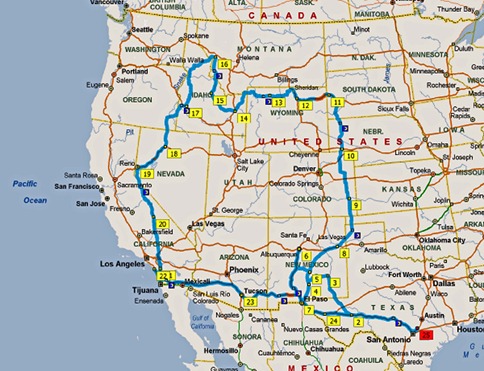 We started the year in our usual spot in Texas, and in early March we left for a stay in Southern New Mexico. We revisited Carlsbad Caverns, explored
We started the year in our usual spot in Texas, and in early March we left for a stay in Southern New Mexico. We revisited Carlsbad Caverns, explored 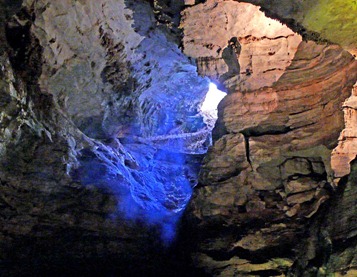 Roswell and the “International UFO Museum and Research Center” (the name was a lot more impressive than the place itself), and the grave of Billy the Kid before heading over the mountains to Alamogordo.
Roswell and the “International UFO Museum and Research Center” (the name was a lot more impressive than the place itself), and the grave of Billy the Kid before heading over the mountains to Alamogordo. 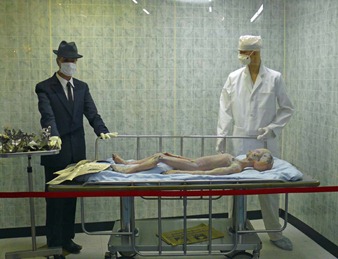 We visited familiar haunts like the Inn of the Mountain Gods, Sunspot, Lincoln, and White Sands, then headed North to Albuquerque for a big-city stay. We then decided to head down the interstate to El Paso and a month at Fort Bliss’ great campground. El Paso is an interesting town; part truck terminal, part border town, and mostly dusty, but we enjoyed our stay before finally heading north again, this time
We visited familiar haunts like the Inn of the Mountain Gods, Sunspot, Lincoln, and White Sands, then headed North to Albuquerque for a big-city stay. We then decided to head down the interstate to El Paso and a month at Fort Bliss’ great campground. El Paso is an interesting town; part truck terminal, part border town, and mostly dusty, but we enjoyed our stay before finally heading north again, this time  on our way to South Dakota and our volunteer stay. Our route took us through Northeast New Mexico, a small part of Oklahoma, Eastern Colorado, Nebraska, and finally, Western South Dakota and the Black Hills. We arrived at our summer home in Spearfish in late April to a snowstorm and gray skies, but a warm welcome from our volunteer host and fellow volunteers.
on our way to South Dakota and our volunteer stay. Our route took us through Northeast New Mexico, a small part of Oklahoma, Eastern Colorado, Nebraska, and finally, Western South Dakota and the Black Hills. We arrived at our summer home in Spearfish in late April to a snowstorm and gray skies, but a warm welcome from our volunteer host and fellow volunteers.
 We quickly immersed ourselves in the history and current operation of the D.C. Booth Historic National Fish Hatchery, and began giving tours of the various exhibits and operating the gift shop. Each time we volunteer we learn something new, and here we were
We quickly immersed ourselves in the history and current operation of the D.C. Booth Historic National Fish Hatchery, and began giving tours of the various exhibits and operating the gift shop. Each time we volunteer we learn something new, and here we were 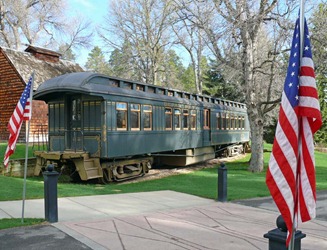 amazed at the history of the effort to stock the Western US with fish for both food and sport, something that began in the 1870s. The Black Hills were a great example – when Custer explored the area in 1874, the beautiful streams throughout the area had minnows and suckers, but no trout until stocking operations began in the late 1800s. It was always interesting to see the reaction from visitors from Western states when they learned that fish like bass, trout, and even carp were not native to their area. Besides a learning experience, our volunteering here gave us great access to the Black Hills – what an amazing area! Surrounded by green, rolling hills, the Black Hills, which are really mountains, are an interesting contrast of rocky crags, wildflower-covered valleys, and forests. We were truly amazed at how beautiful they were, and how many things there were to see and do.
amazed at the history of the effort to stock the Western US with fish for both food and sport, something that began in the 1870s. The Black Hills were a great example – when Custer explored the area in 1874, the beautiful streams throughout the area had minnows and suckers, but no trout until stocking operations began in the late 1800s. It was always interesting to see the reaction from visitors from Western states when they learned that fish like bass, trout, and even carp were not native to their area. Besides a learning experience, our volunteering here gave us great access to the Black Hills – what an amazing area! Surrounded by green, rolling hills, the Black Hills, which are really mountains, are an interesting contrast of rocky crags, wildflower-covered valleys, and forests. We were truly amazed at how beautiful they were, and how many things there were to see and do.
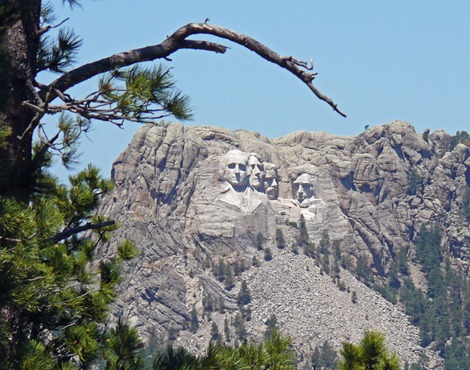
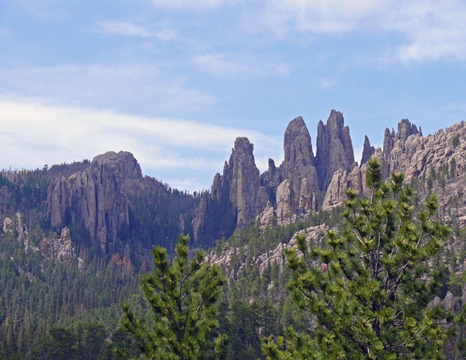
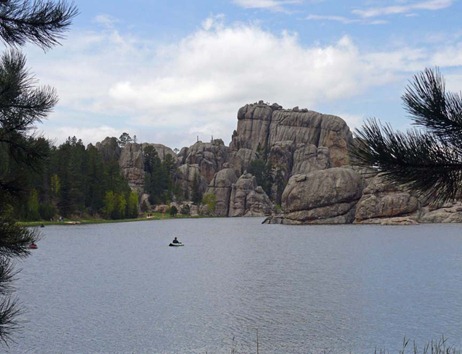
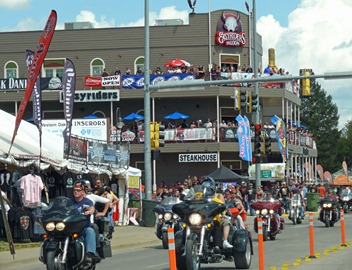 We managed to survive the Sturgis Rally experience, although having seen it once we’ll pass on future visits. 600,000 bikers concentrated around a small town of 3000 is an interesting sight. Besides, each year the crowd gets older – who wants to see a bunch of senior citizens, dressed like youthful rebels, roaring around like teenagers on motorcycles?
We managed to survive the Sturgis Rally experience, although having seen it once we’ll pass on future visits. 600,000 bikers concentrated around a small town of 3000 is an interesting sight. Besides, each year the crowd gets older – who wants to see a bunch of senior citizens, dressed like youthful rebels, roaring around like teenagers on motorcycles?
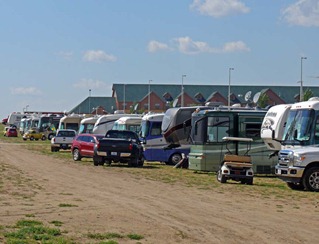
Leaving Spearfish, we drove west to Gillette, Wyoming and the annual Escapees Rally. We enjoyed the entertainment, the educational seminars, and the camaraderie of the rally, but decided that the industrial town of Gillette wasn’t on our list to revisit.
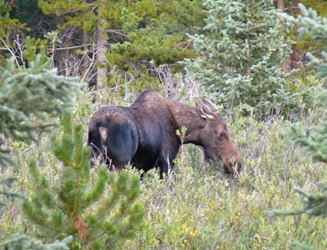 From Gillette, we journeyed on to the wonderful small village of Ten Sleep, with it’s great scenery including a moose sighting or two. Then on to Cody for a week’s stay. A tourist town that still has managed to keep it’s character, we enjoyed the area
From Gillette, we journeyed on to the wonderful small village of Ten Sleep, with it’s great scenery including a moose sighting or two. Then on to Cody for a week’s stay. A tourist town that still has managed to keep it’s character, we enjoyed the area  and took a day trip to again drive America’s most beautiful highway, the Beartooth All American Road. A visit to the Heart Mountain National Historic Site was an educational visit on that it wasn’t that long ago that our
and took a day trip to again drive America’s most beautiful highway, the Beartooth All American Road. A visit to the Heart Mountain National Historic Site was an educational visit on that it wasn’t that long ago that our 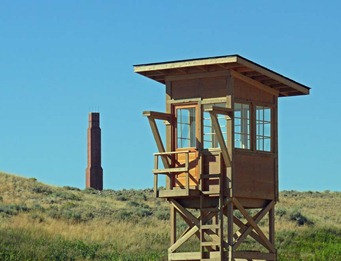 country forgot democracy and imprisoned it’s own citizens. A less than uplifting experience, but one everyone should see and remember.
country forgot democracy and imprisoned it’s own citizens. A less than uplifting experience, but one everyone should see and remember.
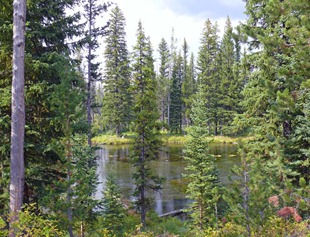
Leaving Cody, we drove through crowded Yellowstone National Park and turned south into Idaho. We’d never been to this part of the state, and were amazed with the beauty. Deep forests, mountains, and lakes were everywhere, and the sparse number of people was a welcome relief after all of the tourist spots in Wyoming. We turned west to intercept the Salmon River Valley and spent time in the small town of Challis. From here, we visited the Sawtooth Valley and the small town of Stanley, a place of awesome beauty and cold, cold winters. You could easily tell the homes of the winter residents by the huge piles of firewood, some bigger than the home itself.
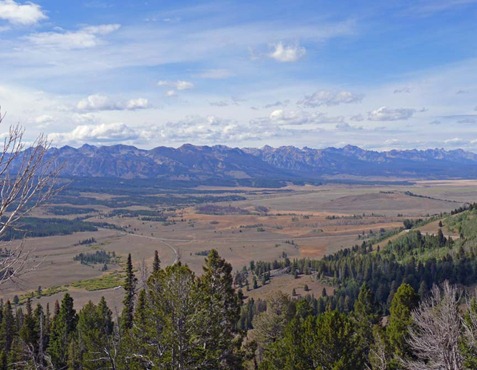
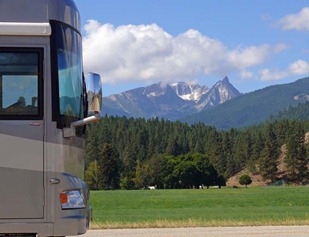 We continued up the valley, then over Lost Trail Pass into Montana and the Bitterroot Valley. Of all the places we’ve been, this is the one place that we always feel the need to return to. We spent a week exploring our favorite places and visiting old friends from the Lee Metcalf National Wildlife Refuge. Six years ago, we were the first “resident” volunteers here, and the refuge staff, like us, wasn’t sure what we’d gotten into. Now, we consider the folks there lifelong friends and always look forward to seeing them again.
We continued up the valley, then over Lost Trail Pass into Montana and the Bitterroot Valley. Of all the places we’ve been, this is the one place that we always feel the need to return to. We spent a week exploring our favorite places and visiting old friends from the Lee Metcalf National Wildlife Refuge. Six years ago, we were the first “resident” volunteers here, and the refuge staff, like us, wasn’t sure what we’d gotten into. Now, we consider the folks there lifelong friends and always look forward to seeing them again.
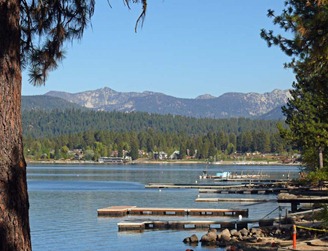 From Montana, we traveled over Lolo Pass back into Idaho, and turned south into new territory for us. Idaho continued to amaze us with it’s beauty; the mountains, the forests – and so much of it unspoiled by population
From Montana, we traveled over Lolo Pass back into Idaho, and turned south into new territory for us. Idaho continued to amaze us with it’s beauty; the mountains, the forests – and so much of it unspoiled by population  centers. We visited McCall, then spent two weeks in Boise, a vibrant city with the best Farmer’s Market we’ve seen. What a great downtown area – full of restaurants, stores, and parks. Here, we allowed our inner child to take over, and traded our well-worn Tribute SUV in on an MX-5 Miata, a car that makes no sense as a tow vehicle, but sure is fun! After wearing out the mountain roads surrounding Boise, we headed to our next stop in Sparks, Nevada.
centers. We visited McCall, then spent two weeks in Boise, a vibrant city with the best Farmer’s Market we’ve seen. What a great downtown area – full of restaurants, stores, and parks. Here, we allowed our inner child to take over, and traded our well-worn Tribute SUV in on an MX-5 Miata, a car that makes no sense as a tow vehicle, but sure is fun! After wearing out the mountain roads surrounding Boise, we headed to our next stop in Sparks, Nevada.

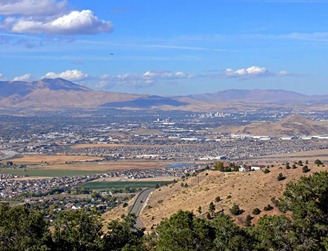 We spent two weeks in Sparks, giving Brenda the chance to fly back to Ohio for a visit with her mom, then headed down the East side of the Sierras. Highway 395 is an interesting route; lots of scenery, few people, and some great places to stop and explore. We spent a week at Lone Pine, in the shadow of Mount Whitney, where we traveled to many of the places we saw in the movies. Whether it was an old classic like “High Sierra”, a serial western like the Roy Rogers Show, or a newer movie like “Tremors”, the area has provided the backdrop for many of our favorites. We traveled to Death Valley (and asked ourselves why?), visited the wonderful visitor center at Manzanar NHS, and each day marveled at the scenery.
We spent two weeks in Sparks, giving Brenda the chance to fly back to Ohio for a visit with her mom, then headed down the East side of the Sierras. Highway 395 is an interesting route; lots of scenery, few people, and some great places to stop and explore. We spent a week at Lone Pine, in the shadow of Mount Whitney, where we traveled to many of the places we saw in the movies. Whether it was an old classic like “High Sierra”, a serial western like the Roy Rogers Show, or a newer movie like “Tremors”, the area has provided the backdrop for many of our favorites. We traveled to Death Valley (and asked ourselves why?), visited the wonderful visitor center at Manzanar NHS, and each day marveled at the scenery. 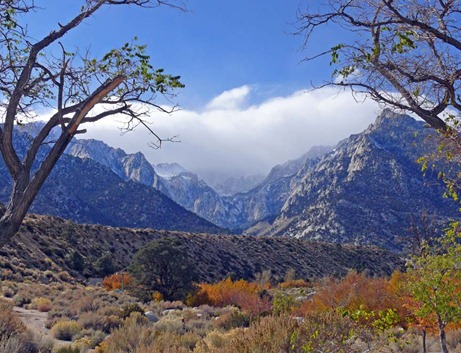
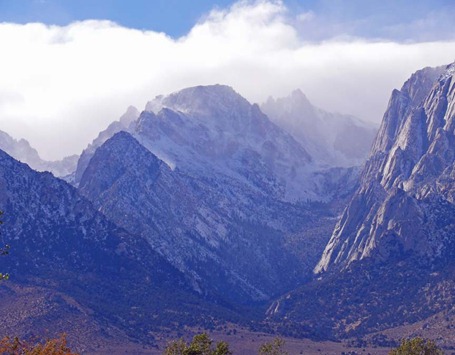 Driving South again, we spent time in Temecula sightseeing and visiting friends, then headed for the Southern California coast for Thanksgiving with our daughter and her husband. We had a great time, but too soon had to pack up and start our journey back to Texas with stops along the way to visit friends.
Our favorites list for this year: Best RV Park: The volunteer village in Spearfish. Tree shaded, grass sites with paved pads that backed up against trout-stocked Spearfish Creek. With a large common area complete with 20-foot trout-shaped fireplace, it was a place where we made friends, enjoyed pot lucks, and had a glass of wine or two. Runner-up: Sparks Marina RV Resort. A true resort with outstanding facilities and no annoying sprinkler system to contend with (the grass is plastic!). Most Scenic Area: The Black Hills of South Dakota. What a marvelous place! We hadn’t visited until this year, but we’ll be back. Runner up: A tie between Idaho’s Sawtooth Valley and Lone Pine’s view of the Sierras and Mount Whitney. Brenda’s Best Casino: Western Village Hotel Casino, Sparks, NV. Unpretentious, friendly staff, and good slot play. Worst: Any casino in downtown Deadwood, SD. Best Dining Experience: The smoked prime rib at the Elk Mountain RV Resort in tiny Stanley, ID.
Driving South again, we spent time in Temecula sightseeing and visiting friends, then headed for the Southern California coast for Thanksgiving with our daughter and her husband. We had a great time, but too soon had to pack up and start our journey back to Texas with stops along the way to visit friends.
Our favorites list for this year: Best RV Park: The volunteer village in Spearfish. Tree shaded, grass sites with paved pads that backed up against trout-stocked Spearfish Creek. With a large common area complete with 20-foot trout-shaped fireplace, it was a place where we made friends, enjoyed pot lucks, and had a glass of wine or two. Runner-up: Sparks Marina RV Resort. A true resort with outstanding facilities and no annoying sprinkler system to contend with (the grass is plastic!). Most Scenic Area: The Black Hills of South Dakota. What a marvelous place! We hadn’t visited until this year, but we’ll be back. Runner up: A tie between Idaho’s Sawtooth Valley and Lone Pine’s view of the Sierras and Mount Whitney. Brenda’s Best Casino: Western Village Hotel Casino, Sparks, NV. Unpretentious, friendly staff, and good slot play. Worst: Any casino in downtown Deadwood, SD. Best Dining Experience: The smoked prime rib at the Elk Mountain RV Resort in tiny Stanley, ID. 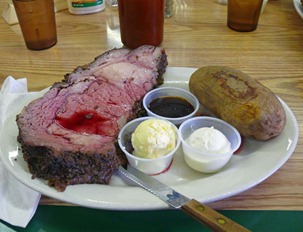 We were told that during the summer, people start lining up at 3 O'clock for the 5 PM serving. We’d be there at noon….incredible! Runner Up: The Shoot the Bull Sunday buffet in Spearfish, SD. Omelets and prime rib – what a way to start the day! Most Memorable Experience: Volunteering at D.C. Booth was an experience we’ll always remember. The beautiful, park-like setting, interesting job of interpreting the history of fisheries in the West, and the great camaraderie among the friends and staff – not to mention the numerous pot-lucks! Thanks, Renae, for allowing us the opportunity to be a part of your volunteer team!
We haven’t firmed up our plans for 2012, although we’re leaning toward returning to the Pacific Northwest. Until then, we’ll be wandering around the Texas coast looking for things to see, so as the locals say, “Y’all Come Back!”
We were told that during the summer, people start lining up at 3 O'clock for the 5 PM serving. We’d be there at noon….incredible! Runner Up: The Shoot the Bull Sunday buffet in Spearfish, SD. Omelets and prime rib – what a way to start the day! Most Memorable Experience: Volunteering at D.C. Booth was an experience we’ll always remember. The beautiful, park-like setting, interesting job of interpreting the history of fisheries in the West, and the great camaraderie among the friends and staff – not to mention the numerous pot-lucks! Thanks, Renae, for allowing us the opportunity to be a part of your volunteer team!
We haven’t firmed up our plans for 2012, although we’re leaning toward returning to the Pacific Northwest. Until then, we’ll be wandering around the Texas coast looking for things to see, so as the locals say, “Y’all Come Back!”
 We’re enjoying our stay here on the Texas Coast; there’s a bit of everything to see and do, from the big city to quiet rural areas. We frequently make the 25 mile drive down the road to Corpus Christi, a typical large town with the usual strip malls and crowded roads. What sets Corpus Christi apart is the waterfront – miles of parks and marinas provide great places to take the kids, have a picnic, or just watch the abundant shorebirds and occasional dolphin as they hunt for fish.
We’re enjoying our stay here on the Texas Coast; there’s a bit of everything to see and do, from the big city to quiet rural areas. We frequently make the 25 mile drive down the road to Corpus Christi, a typical large town with the usual strip malls and crowded roads. What sets Corpus Christi apart is the waterfront – miles of parks and marinas provide great places to take the kids, have a picnic, or just watch the abundant shorebirds and occasional dolphin as they hunt for fish.  Another of our favorite places to visit is Port Aransas, a short (and free) ferry ride across the bay. Port Aransas has the usual tourist spots, and a large marina next to the ferry landing. From an observation
Another of our favorite places to visit is Port Aransas, a short (and free) ferry ride across the bay. Port Aransas has the usual tourist spots, and a large marina next to the ferry landing. From an observation  tower, we watched as the ferries worked their way back and forth – we’ve never waited more than 10 minutes to drive on. There are at least eight ferry boats, with crews both on board and on the loading areas, all to cross a short distance – we wonder why they don’t just build a bridge?
tower, we watched as the ferries worked their way back and forth – we’ve never waited more than 10 minutes to drive on. There are at least eight ferry boats, with crews both on board and on the loading areas, all to cross a short distance – we wonder why they don’t just build a bridge?  This time of year the water is covered with ducks; mostly Teal, Pintail, and Shovelers, but on our last visit we were surprised to see a large, and I mean LARGE, alligator prowling the pond. He was around 10 feel long, with a massive head, and we watched
This time of year the water is covered with ducks; mostly Teal, Pintail, and Shovelers, but on our last visit we were surprised to see a large, and I mean LARGE, alligator prowling the pond. He was around 10 feel long, with a massive head, and we watched  as he worked his way through the shallow water and mud. The waterfowl didn’t seem too alarmed, but they didn’t get too close, either. Since the reeds were crowded with sleeping ducks, he probably didn’t have to work too hard to find a meal. I guess there’s a reason for the cute sign warning of alligators after all!
as he worked his way through the shallow water and mud. The waterfowl didn’t seem too alarmed, but they didn’t get too close, either. Since the reeds were crowded with sleeping ducks, he probably didn’t have to work too hard to find a meal. I guess there’s a reason for the cute sign warning of alligators after all!  Today, there are just a few beach houses where the town once stood. We found the site of the original courthouse, and visited the cemetery where entire families are interred from the hurricanes.
Today, there are just a few beach houses where the town once stood. We found the site of the original courthouse, and visited the cemetery where entire families are interred from the hurricanes.  It’s hard to believe looking around that this was once such a vibrant town and important seaport, and it’s too bad that there isn’t more information available about the lives of the people here. Can you imagine a time when a hurricane appeared without warning? What would we do without “Storm Tracker Doppler High-definition Weather Radar”? Whatever that is.
It’s hard to believe looking around that this was once such a vibrant town and important seaport, and it’s too bad that there isn’t more information available about the lives of the people here. Can you imagine a time when a hurricane appeared without warning? What would we do without “Storm Tracker Doppler High-definition Weather Radar”? Whatever that is.





























